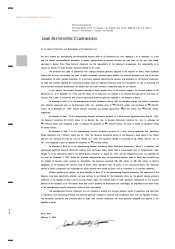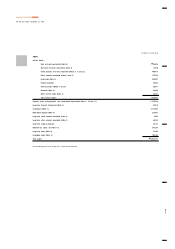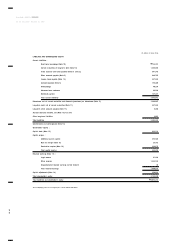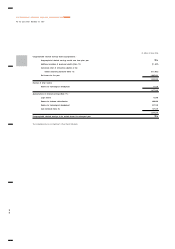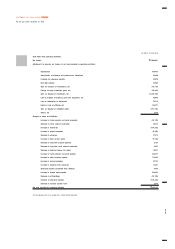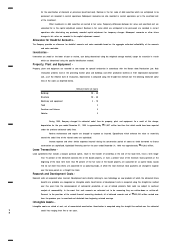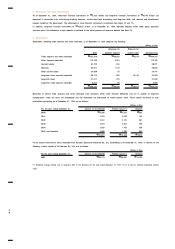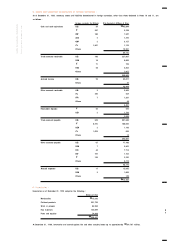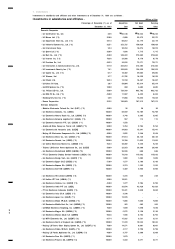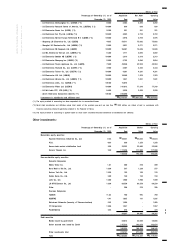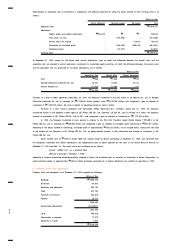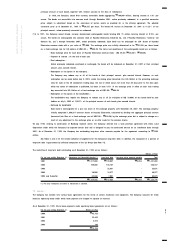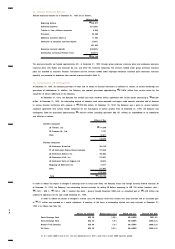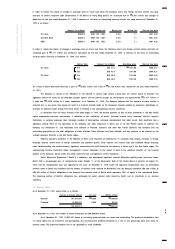LG 1999 Annual Report Download - page 31
Download and view the complete annual report
Please find page 31 of the 1999 LG annual report below. You can navigate through the pages in the report by either clicking on the pages listed below, or by using the keyword search tool below to find specific information within the annual report.
9
2
NOTES TO FINANCIAL STATEMENTS
For the year ended December 31, 1999
Discounts (Premiums) on Debentures -
Discounts (Premiums) on debentures are amortized using the effective interest rate method over the repayment period of the debentures. The
amortized amount is included in interest expense.
Treasury Debentures -
When treasury debentures are acquired, the face value and any discount or premium is subtracted from the related accounts. The difference
between the book value and acquisition cost of the treasury debentures is charged to current operations as a gain or loss on
redemption of debentures.
Accrued Severance Benefits -
Employees and directors with more than one year of service are entitled to receive a lump-sum severance payment upon termination of their
employment with the Company, based on their length of service and rate of pay at the time of termination. Accrued severance benefits
represents the amount which would be payable assuming all eligible employees and directors were to terminate their employment as of
the balance sheet date.
Pursuant to the revised Financial Accounting Standards generally accepted in the Republic of Korea effective January 1, 1999,
underaccrued severance benefits of
₩
11,907 million as of December 31, 1998 were deducted from retained earnings as of January 1,
1999.
The contributions to national pension fund made under the National Pension Plan and the severance insurance deposit are
deducted from accrued severance benefits. Contributed amounts are refunded from the National Pension Plan and the insurance
companies to employees on their retirement.
Income Taxes -
The Company recognizes deferred income taxes for anticipated future tax consequences resulting from temporary differences between amounts
reported for financial accounting and income tax purposes. Deferred tax assets and liabilities are computed on such temporary
differences including tax credits by applying enacted statutory tax rates applicable to the years when such differences are expected to
be reversed. Deferred tax assets are recognized to the extent that it is more likely than not that such deferred tax assets will be
realized. The total income tax provision includes current tax expenses under applicable tax regulations and the change in the balance of
deferred tax assets and liabilities.
Tax credits for investments and development of technology and manpower are accounted for using the flow-through method,
whereby they reduce income taxes in the period the assets giving rise to such credits are placed in service. To the extent such credits
are not currently utilized, deferred tax assets, subject to realizability as stated above, are recognized for the carry-forward amount.
Sale of Accounts and Notes Receivables -
The Company sells certain accounts or notes recievable to financial institutions at a discount, and accounts for the transactions as sales
of the receivables if the rights and obligations relating to the receivables are substantially transferred to the buyers. The gains and
losses from the sales of the receivables are charged to operations as incurred.
Foreign Currency Translation -
Monetary assets and liabilities denominated in foreign currencies are translated into Korean Won at the basic rates in effect at the balance sheet
date (US$ 1 :
₩
1,145.40), and resulting translation gains and losses are recognized currently. Foreign currency denominated convertible
bonds are translated at the historical exchange rates prevailing as of the date of issuance.
Derivative Financial Instruments -
The Company utilizes several derivative financial instruments such as forward exchange, swap and option contracts to reduce its exposure resulting
from fluctuations in foreign currency and interest rates. The instruments are valued at fair market value. For derivative financial
instruments used to hedge risk arising from underlying transactions or commitments, gains or losses on valuation of the instruments are
charged to current operations when incurred. For derivative financial instruments used to hedge potential risk on anticipated future
transactions, gains or losses on valuation of the instruments are recorded as an adjustment to capital when incurred.
Significant Changes in Financial Accounting Standards in Korea -
The Company adopted the revised Financial Accounting Standards in the Republic of Korea effective January 1, 1999. Pursuant to the provision of
the revised financial accounting standards, the Company recognized deferred income taxes, adopted the equity method of accounting for
investments in equity securities of affiliated companies over which the Company can exercise significant influence, and charged research
costs to expense. The cumulative effect on assets and liabilities arising in accordance with adoption of revised standards was added to
or deducted from beginning retained earnings or capital adjustments pursuant to the revised accounting standards.
As a result of cumulative effects of retroactive adoption of the revised Financial Accounting Standards, retained earnings as
of January 1, 1999 and net income for the year ended December 31, 1999 were decreased by
₩
727,055 million and
₩
77,198
million, respectively, and capital adjustments as of December 31, 1999 was increased by
₩
208,159 million (see Note 17).



